Dangerous creatures captivate the imagination with their lethal abilities and the threat they pose to humans. This fascination is coupled with a primal fear, underscoring the importance of understanding and respecting these animals to ensure safety. The creatures selected for this discussion are known for their potential to cause harm, the frequency at which humans may encounter them, and the severity of their attacks. Highlighting these beings sheds light on the delicate balance between human activity and the natural world, emphasizing the need for awareness and precautionary measures.
Contents
Box Jellyfish
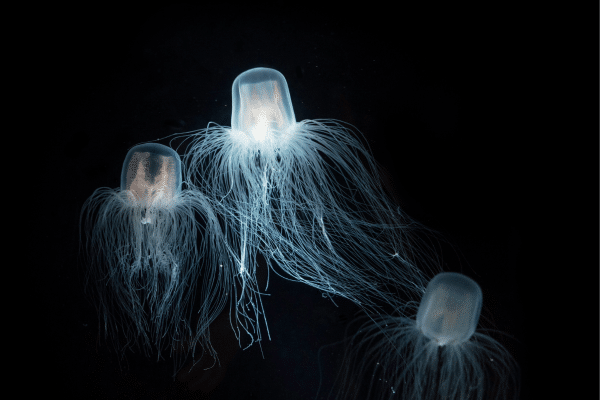
The box jellyfish, often cited as one of the ocean’s most lethal inhabitants, possesses a venom capable of causing excruciating pain and, in some instances, fatal outcomes for humans. Its nearly transparent body and tentacles make it nearly invisible in its natural habitats, primarily the warm waters of the Pacific and Indian oceans. The creature’s venom is among the most deadly in the world, containing toxins that attack the heart, nervous system, and skin cells. The immediate and intense pain from a sting often leads to shock, drowning, or heart failure in victims, underscoring the jellyfish’s reputation for danger.
Despite its fearsome reputation, encounters with box jellyfish can be mitigated through various safety precautions and awareness. Beachgoers are advised to wear protective clothing, such as full-body swim suits, and to heed local warnings and beach closures. In regions where box jellyfish are common, vinegar is often stocked by lifeguards to neutralize the stinging cells as a first aid measure, although medical attention is urgently required for stings. The development of antivenoms and treatments has improved survival rates, but the best strategy remains avoidance and education about these enigmatic creatures.
Inland Taipan

The inland taipan, residing in the remote, arid regions of Australia, holds the title for the world’s most venomous snake. Its venom is so potent that a single bite contains enough neurotoxins and myotoxins to kill 100 adult humans. Despite its deadly potential, the inland taipan is remarkably reclusive, avoiding human contact whenever possible. Its preference for secluded habitats significantly reduces the likelihood of encounters with people, which, in turn, minimizes the number of bites reported annually. This snake’s elusive nature, combined with its lethal venom, makes it a fascinating subject of study for herpetologists and toxin researchers alike.
Fortunately, the rarity of inland taipan bites is matched by the effectiveness of the available antivenom, which, when administered in time, can prevent the venom’s fatal consequences. Awareness and education about the snake’s habitat, behavior, and the immediate steps to take in the event of a bite are essential for those living in or visiting its natural environment. Medical facilities in areas within the snake’s range are equipped with the necessary antivenom, and advancements in medical treatment have ensured that there have been no recorded fatalities from inland taipan bites in recent history. The snake’s case underscores the importance of rapid medical intervention and the balance between fear and respect for the natural world’s most dangerous inhabitants.
Saltwater Crocodile
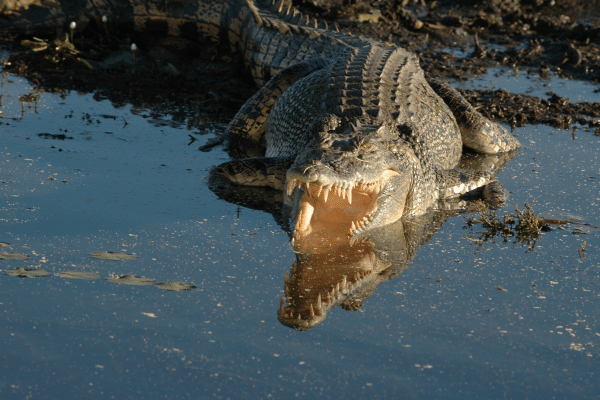
The saltwater crocodile, the largest of all living reptiles, commands a fearsome reputation for its sheer size, strength, and aggressive nature. Found in a range of habitats from India through Southeast Asia to northern Australia, these apex predators can grow up to 7 meters in length and weigh over a ton. Their ability to remain nearly completely submerged and undetected in water makes them exceptional ambush predators, capable of taking down almost any animal that ventures too close to the water’s edge. The combination of power, stealth, and aggression has solidified the saltwater crocodile’s status as one of the most dangerous creatures to humans in their shared environments.
Human encounters with saltwater crocodiles often occur in areas where human activities encroach upon their natural habitats. These interactions can lead to tragic outcomes, particularly in regions where people use waterways for fishing, washing, and transportation. Awareness campaigns and crocodile management programs aim to minimize these conflicts by educating communities about crocodile behavior and safety measures. Enclosures and warning signs near known crocodile habitats, along with the relocation of problem crocodiles, have been effective in reducing the number of attacks. Despite their danger, saltwater crocodiles play a crucial role in maintaining the ecological balance in their environments, highlighting the need for conservation efforts that protect both human and crocodile populations.
African Elephant
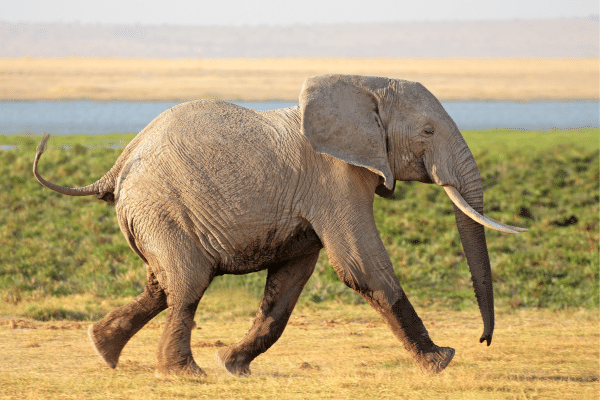
The African elephant, recognized as the largest land animal on Earth, exhibits a generally peaceful demeanor but can become one of the most dangerous animals when provoked or threatened. Their immense size, which can exceed 6,000 kilograms and stand up to 4 meters at the shoulder, combined with their powerful tusks, makes them capable of causing significant destruction. Conflicts between humans and elephants arise primarily due to habitat encroachment and poaching, leading to situations where elephants may attack vehicles or buildings when they feel cornered or harassed. While such incidents are relatively rare, they underscore the potential danger posed by these majestic creatures when their space and families are threatened.
Conservation efforts for African elephants focus on protecting their habitats and creating corridors that allow them to migrate without coming into close contact with human populations. These initiatives help to reduce human-elephant conflicts and ensure the survival of these magnificent animals for future generations. Educating communities living near elephant habitats on how to live in harmony with these giants is crucial. Measures include securing food sources to prevent elephant raids and employing non-lethal deterrents to keep elephants away from human settlements. The goal is to foster coexistence, ensuring the safety of both humans and elephants in shared landscapes.
Poison Dart Frog
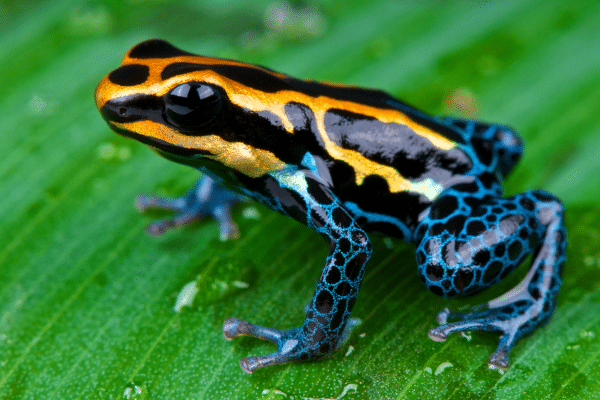
The poison dart frog, a small creature native to the rainforests of Central and South America, belies its danger with vibrant colors that range from bright yellow to deep blue. These colors serve as a warning to predators about the toxic secretions found in the frog’s skin, which indigenous peoples have historically used to poison the tips of their darts and arrows. A single frog can carry enough toxin to deter would-be predators or, in some cases, cause serious harm to humans if handled without proper care. The toxins vary in potency among different species of dart frogs, but all serve as a potent defense mechanism against predation.
The fascination with poison dart frogs extends beyond their toxicity to their potential benefits for medical research. Scientists are studying the compounds found in the frogs’ skin for possible applications in painkillers and other medications. However, habitat loss and the pet trade pose significant threats to their populations. Efforts to conserve their habitats and regulate trade are crucial for ensuring their survival. While their toxins make them one of the most dangerous creatures on Earth, their ecological role and potential benefits to humanity underscore the importance of their preservation.
Cape Buffalo
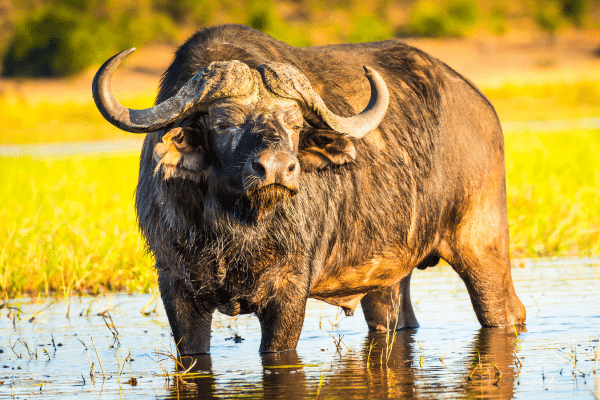
The Cape buffalo, often referred to as Africa’s most dangerous game, earns its reputation from its unpredictable nature and the sheer force it can exert. Known for their solid build and distinctive curved horns, which can span up to a meter across, these animals are formidable opponents. Despite their herbivorous diet, Cape buffaloes are known to charge with lethal force at perceived threats, including lions and humans. This aggressive behavior, combined with their tendency to travel in large herds, makes any encounter with them potentially perilous, especially for those on foot in the African bush.
Safety measures for those living in or visiting areas inhabited by Cape buffalo include maintaining a safe distance, traveling in vehicles whenever possible, and avoiding any actions that could provoke a charge. Professional guides and rangers are trained to recognize signs of agitation in these animals and can navigate safely around them. Conservation efforts focus on maintaining the natural habitats of the Cape buffalo and mitigating the factors that lead to human-buffalo conflicts. By understanding the behavior and needs of these powerful creatures, strategies can be implemented to reduce the dangers they pose to humans while ensuring their survival in the wild.
Great White Shark
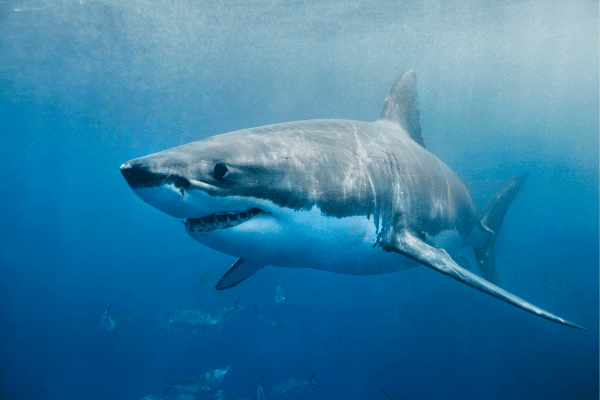
The great white shark, often misunderstood as a mindless man-eater, is actually a sophisticated and curious apex predator of the oceans. Their impressive size, powerful jaws, and rows of sharp teeth are designed for feeding on seals, fish, and dead whales rather than humans. Attacks on humans are extremely rare and often result from curiosity rather than predation. The media’s portrayal of great white sharks has contributed to a widespread fear that exceeds the actual risk posed by these majestic creatures. Conservation efforts aim to protect sharks from overfishing and bycatch, which threaten their populations worldwide.
Shark conservation is vital for the health of marine ecosystems, as sharks play a crucial role in maintaining the balance of marine life by preying on sick and weak individuals. Safety measures for humans include swimming in groups, avoiding the water at dawn and dusk when sharks are most active, and staying away from areas known for seal colonies. Through education and conservation, the goal is to reduce unfounded fears and promote a better understanding of great white sharks. By respecting these creatures and their habitat, humans can minimize the risks of encounters while supporting efforts to conserve these essential predators.
The Bottom Line
The creatures highlighted in this discussion exemplify the diversity and complexity of Earth’s fauna. Each, in its own right, demands respect and caution due to the potential danger it poses to humans. However, these dangers do not exist in isolation; they are often exacerbated by human actions that encroach upon natural habitats or provoke defensive responses. The key to coexisting with these animals lies in education, conservation, and adopting practices that minimize negative interactions. By fostering respect and understanding, humans can appreciate the marvels of these dangerous creatures from a safe distance, ensuring the safety and preservation of both human lives and the natural world.


